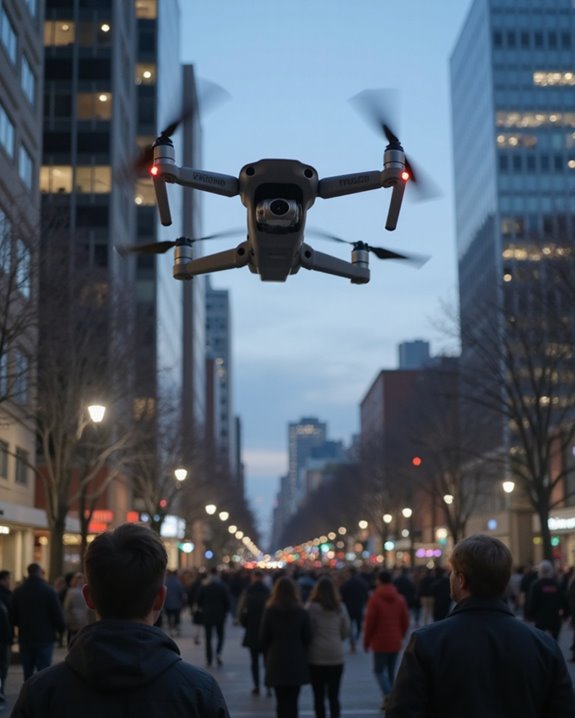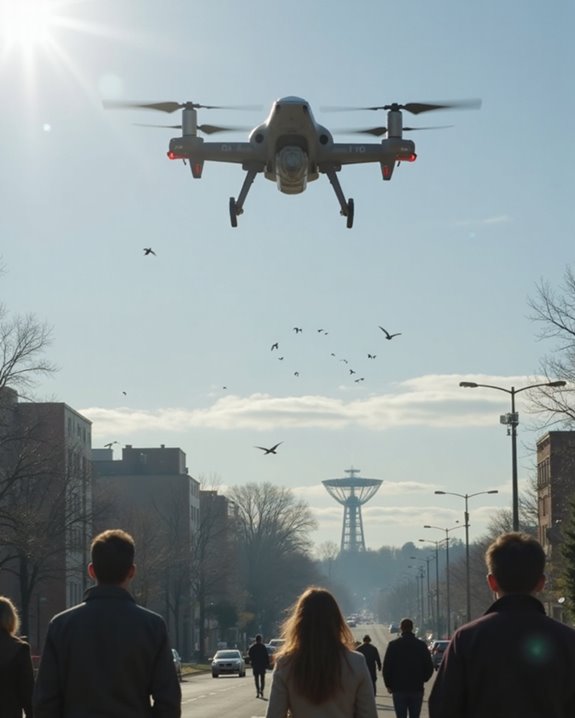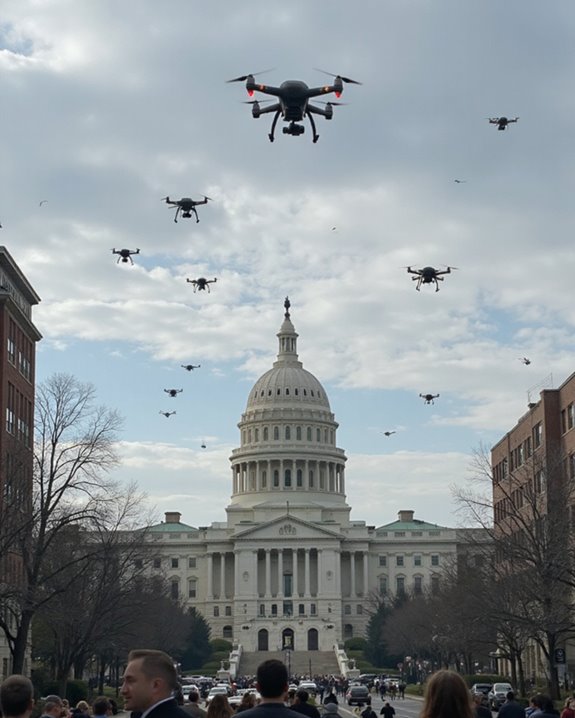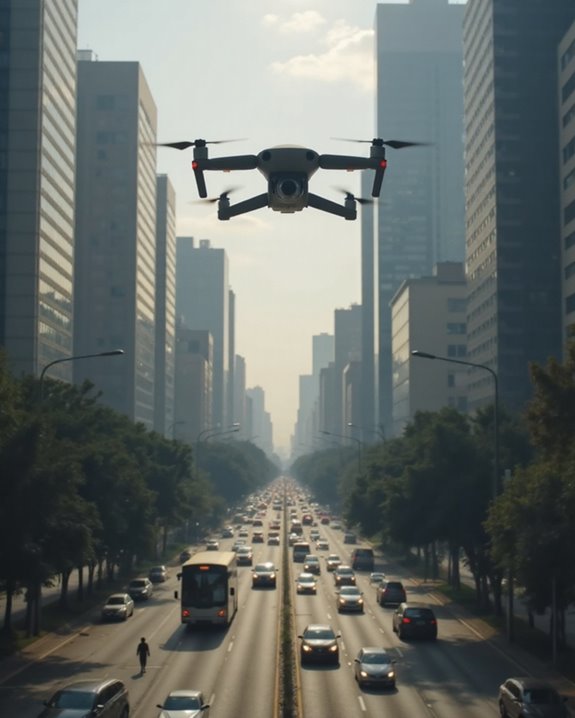Drones might seem like cool tech toys or handy business tools, but they aren’t just harmless gadgets zipping by! With over 850,000 registered in the US and sales soaring past $1.25 billion, drones are everywhere—bringing jobs, but also safety and airspace headaches, from spinning propeller injuries to risky airport flybys. Even privacy and noise become issues when drones peek over fences or hum overhead. Curious how these buzzing machines are changing the skies? You’re in the right spot for answers.
Key Takeaways
- Drones pose safety risks, with thousands of reported injuries and rare fatalities linked to their misuse or accidents.
- Unauthorized drone flights near airports and in restricted zones threaten airspace security and public safety.
- Drones raise privacy concerns due to their ability to capture images over fences and through windows.
- Existing regulations struggle to keep pace with rapid drone adoption, leading to compliance and enforcement challenges.
- While drones drive economic growth and job creation, they also introduce new hazards like noise, cybersecurity risks, and environmental impacts.
The Rise of Drone Ownership in the US
Let’s take a closer look at how drones are taking off—literally and figuratively—across the United States! Drones aren’t just for techies anymore; they’ve become a favorite among people who love recreational hobbies. As of 2025, there are about 855,860 registered drones in the country, with nearly two-thirds of these buzzing around for fun rather than business. Demographic trends show that most drone owners are men, especially those aged 45-54, who make up the largest group. While women are just 4% of owners, maybe drone clubs need more pink stickers! Sales have soared, with over $1.25 billion spent on consumer drones in 2020 alone. As drones become more affordable and accessible, people of all backgrounds are joining the flight. Many new users are opting for refurbished DJI drones, which combine affordability with advanced safety features.
Safety Risks Associated With Drone Usage

How safe are drones, really, when they whiz across backyards and city parks? While these flying gadgets look fun, they do carry real health hazards. Did you know that, between 2015 and 2020, about 4,250 drone-related injuries were reported? Most were lacerations—ouch, those spinning propellers do not mess around! Fingers get the worst of it, but heads and legs aren’t exactly safe zones, either. Accident prevention is key, yet federal guidelines like Part 107 don’t cover every possible safety risk. Sure, most folks walk away with just a bandage and a good story, but there’s even been an electrocution fatality from retrieving a drone off power lines. So, while drones can be cool, a little caution really goes a long way! Modern drones often include obstacle avoidance features to help reduce collision risks and improve flight safety.
Drones and Airspace Security Challenges

A new era of challenges has arrived with the rise of drones, especially when it comes to airspace security! Imagine over 2,000 drone sightings popping up near U.S. airports in just six months—talk about a headache for airspace monitoring teams. Drones have zipped into restricted zones above places like San Diego International, sometimes soaring way above legal altitude limits. That’s not just breaking rules—it’s flirting with disaster for manned aircraft. On top of that, criminals and even cartels have used drones to smuggle contraband, and some experts worry about drones carrying more dangerous cargo. The real kicker? Many agencies are scrambling to catch up, lacking the tech or training for swift drone neutralization. It’s a high-stakes game of cat and mouse! One promising approach gaining traction is the use of RF-blocking products that physically contain drone signals without violating legal restrictions.
Regulatory Landscape and Compliance Issues

Curiously enough, the world of drone rules is almost as fast-moving as the drones themselves! The Regulatory Framework for drones is changing at lightning speed, especially with the FAA Reauthorization Act of 2024 pushing for clear rules—just as people are learning what BVLOS means. Globally, policy is shifting, and certified UTM systems are racing to keep up. Compliance Tools, like Remote ID systems, help pilots follow rules and keep the skies safer, but older drones often need retrofitting, which isn’t cheap or easy! Maneuvering no-fly zones and the slow waiver process for BVLOS operations can feel like a maze. With AI-powered Compliance Tools evolving, operators must stay alert, since falling behind on regulations is easier than losing sight of a tiny drone on a cloudy day.
Economic Growth Versus Emerging Hazards

While the sky’s the limit for drone technology, the battle between booming profits and growing hazards is hard to ignore! The global drone market, set to hit a staggering $54.6 billion by 2025, is fueling impressive job growth—over 2.1 million people now work in the industry, with 126,000 jobs added just last year. That’s a lot of pilots, engineers, and dreamers finding new opportunities! Yet, these soaring achievements come with turbulence. Privacy issues are front and center, as drones can peer over fences and through windows, sometimes making neighbors feel like reality TV stars without the contracts. Add collision risks, cybersecurity threats, noise pollution, and even environmental impact, and you see why enthusiasm for drones must balance economic gains with real, emerging hazards.
Frequently Asked Questions
Can Drones Be Used for Wildlife Monitoring and Conservation Efforts?
Drones are effectively utilized in wildlife monitoring and conservation, enabling accurate species counting and tracking migration patterns. They provide high-resolution data, minimize wildlife disturbance, and enhance research efficiency, supporting informed decision-making in habitat management and poaching prevention.
What Are the Privacy Concerns Related to Drone Surveillance?
With over 850,000 drones registered in the U.S., privacy rights face new challenges as drones enable surveillance that easily intrudes on private spaces. Ethical surveillance demands transparency and strict guidelines to prevent unauthorized data capture and eroded trust.
How Are Drones Being Used in Film and Photography Industries?
Drones in film and photography industries enable superior aerial shots, leveraging advanced lens options and gimbal technology for stabilized, high-definition imagery. They are widely adopted for cost-effective, innovative cinematography, location scouting, environmental monitoring, and commercial visual storytelling applications.
Are There Environmental Impacts From Widespread Drone Usage?
Like a swarm of mechanical bees, widespread drone usage can generate drone pollution and energy waste. While drones may reduce vehicle emissions, their electricity demands, manufacturing, and potential ecological disturbance introduce new environmental impacts requiring thorough assessment.
Can Drones Be Hacked or Used for Cyber Attacks?
Drone hacking is a documented threat, as vulnerabilities in software, networks, and APIs can be exploited. Effective cyber defenses, such as strong passwords, encryption, and regular updates, are critical to prevent unauthorized access and cyber attacks on drone systems.





